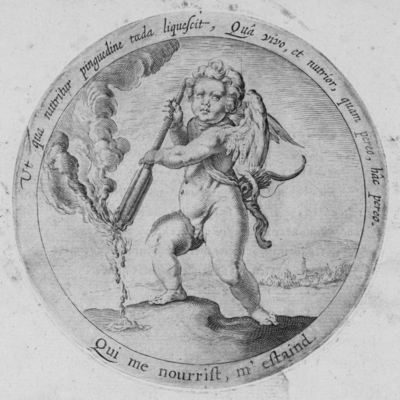Daniël Heinsius, Quaeris quid sit Amor (c. 1601)
Table of contents ↑Qui me nourrist, m’estaind [5]

Het ghene dat de torts/ ontsteeckt/ en doetse
branden/
Dat zelve blust se weer als m’ommekeert zijn handen.
Zoo gaet het met den min/ O wreeden brandt/ O brandt/
Wat baet mijn wijsheydt my/ oft’ treffelick verstandt?
Ick gae hier// ende weer/ ick gae nu zoo veel daghen/
En soecke dees en die/ om myne noot te claghen.
Ick moet weer naer het vier// de ghene diet my doet
Als oorsaeck van mijn vier/ mijn vier oock blussen moet.
Dat zelve blust se weer als m’ommekeert zijn handen.
Zoo gaet het met den min/ O wreeden brandt/ O brandt/
Wat baet mijn wijsheydt my/ oft’ treffelick verstandt?
Ick gae hier// ende weer/ ick gae nu zoo veel daghen/
En soecke dees en die/ om myne noot te claghen.
Ick moet weer naer het vier// de ghene diet my doet
Als oorsaeck van mijn vier/ mijn vier oock blussen moet.


Translations
 |
Wie me voedt, dooft me ook. |
 |
Who feeds me extinguishes me. |
 |
Zoals een fakkel door het vet waarmee hij gevoed wordt, ook weer dooft, zo kom ik om door wie ik leef en wordt gevoed en door degene op wie ik smoorverliefd ben. |
 |
As a torch is extinguished by the fat that feeds it, thus who gives me life, feeds me and infatuates me engenders my death. |
Sources and parallels
- Same emblem in 1608 edition: Qui me nourrist, m’estaind [5]
 (in: Daniël Heinsius, Emblemata amatoria (1607/8)
(in: Daniël Heinsius, Emblemata amatoria (1607/8) )
[Compare
)
[Compare ]
]
- A source for the pictura and the entire emblem: Paradin, Princeliicke Deviisen
 , embl. 208
, embl. 208
- A source for the pictura and the entire emblem: Giovio, Dialogo dell'imprese
 , pp. 200-201
, pp. 200-201
- A source for the pictura: Junius, Emblemata [web]
 , embl. 54
, embl. 54 - Junius uses the image of a torch turned upside down also in the preceding
emblem: Junius, Emblemata [web]
 , embl. 53
, embl. 53 - The motto and main pictorial element can also be found in: De Montenay, Emblèmes
 , embl. 54
, embl. 54 -
Parallel in the 1616 edition (motto and subcriptio the same, pictura mirrored): Qui me nourrist, m'estaind. [29]
 (in: Daniël Heinsius, Ambacht van Cupido, from: Nederduytsche poemata (1616)
(in: Daniël Heinsius, Ambacht van Cupido, from: Nederduytsche poemata (1616) )
[Compare
)
[Compare ]
]
-
A parallel (and probably adaptation) for the pictura: Amor, tela penelopes. [44]
 (in: Jacob Cats, Sinne- en minnebeelden (1627)
(in: Jacob Cats, Sinne- en minnebeelden (1627) )
[Compare
)
[Compare ]
]
-
A parallel (and probably adaptation) for the emblem (motto, latin subscriptio and pictura): Quod nutrit, extinguit [96]
 (in: Otto Vaenius, Amorum emblemata (1608)
(in: Otto Vaenius, Amorum emblemata (1608) )
[Compare
)
[Compare ]
]
References, across this site, to this page:
- Amor, tela penelopes. [44]
 (in: Jacob Cats, Sinne- en minnebeelden (1627)
(in: Jacob Cats, Sinne- en minnebeelden (1627) )
)
- Qui me nourrist, m’estaind [5]
 (in: Daniël Heinsius, Emblemata amatoria (1607/8)
(in: Daniël Heinsius, Emblemata amatoria (1607/8) )
)
- Qui me nourrist, m'estaind. [29]
 (in: Daniël Heinsius, Ambacht van Cupido (1613)
(in: Daniël Heinsius, Ambacht van Cupido (1613) )
)
- Qui me nourrist, m'estaind. [29]
 (in: Daniël Heinsius, Ambacht van Cupido, from: Nederduytsche poemata (1616)
(in: Daniël Heinsius, Ambacht van Cupido, from: Nederduytsche poemata (1616) )
)
- Quod nutrit, extinguit [96]
 (in: Otto Vaenius, Amorum emblemata (1608)
(in: Otto Vaenius, Amorum emblemata (1608) )
)
